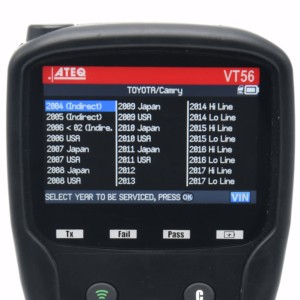The 2004 Toyota Camry utilizes an indirect Tire Pressure Monitoring System (TPMS), meaning it doesn’t rely on physical sensors within the tires. Instead, it leverages the Anti-lock Braking System (ABS) to monitor tire pressure. This differs from later models that use a direct TPMS with sensors. Because of this, there’s no sensor programming or OBD2 tool required for TPMS maintenance on a 2004 Camry.
Understanding the 2004 Camry’s Indirect TPMS
The indirect TPMS in your 2004 Camry works by measuring the rotational speed of each wheel via the ABS sensors. If a tire is low on pressure, its diameter effectively decreases, causing it to rotate faster than the other tires. The system detects this difference in rotational speed and triggers the TPMS warning light on your dashboard.
Performing a TPMS Reset on a 2004 Toyota Camry
Since the 2004 Camry uses an indirect TPMS, the reset procedure is straightforward:
- Inflate Tires: Ensure all tires are inflated to the recommended pressure specified on the tire placard located on the driver’s side doorjamb.
- Engage Parking Brake: Apply the parking brake firmly.
- Turn Ignition On: Turn the ignition key to the “ON” position without starting the engine.
- Press and Hold SET Button: Locate and press the “SET” button, often found beneath the steering wheel or inside the glove compartment. Hold it down for at least three seconds. You should hear a chime or see a confirmation message indicating the TPMS has been reset.
 toyota camry vt56-1
toyota camry vt56-1
This process essentially recalibrates the system to the current tire pressures. After completing these steps, the TPMS warning light should turn off. If it remains illuminated, there might be an issue with the ABS system or a significant pressure difference between tires that requires further inspection.
Key Differences Between Direct and Indirect TPMS
Understanding the difference between direct and indirect TPMS is crucial for proper maintenance.
Indirect TPMS (2004 Camry):
- No tire pressure sensors.
- Relies on ABS sensors for monitoring.
- Simpler reset procedure.
- Less expensive to maintain.
Direct TPMS (Later Camry Models):
- Sensors located inside each tire.
- Provides more precise pressure readings for each tire.
- Requires specialized tools for sensor programming and reset.
- More complex and potentially more expensive to maintain.
Troubleshooting TPMS Issues on a 2004 Camry
If the TPMS light persists after performing a reset, consider these potential issues:
- Significant Tire Pressure Difference: Double-check that all tires are inflated to the recommended pressure. Even a slight difference can trigger the warning light.
- Faulty ABS Sensor: A malfunctioning ABS sensor can disrupt the indirect TPMS readings. Have a mechanic diagnose any potential ABS issues.
- System Malfunction: While less common, there could be a problem with the TPMS control module itself.
This information specifically pertains to the 2004 Toyota Camry. Later Camry models transitioned to a direct TPMS system with different procedures and requirements. Always consult your owner’s manual for the most accurate information for your specific vehicle.

